If you know all about alignment to NCP, just skip to the bottom of the page (alignment in practice) or check out my motor drive by clicking "Next >>" (in the navigation bar, bottom left)
What are the basic alignment requirements ?
Assuming you have bent the screw bolt and measured the hinge/bolt distance correctly, the correct Latitude angle has been built in and the base is has been leveled 'flat' with the ground (using the spirit level), then accuracy of star tracking depends largely on achieving correct alignment with the North Celestial Pole [NCP].
If you set up 'pointing North' then you should only need to rotate the base plate a few degrees to the right or left to line up the hinge toward the pole.
As I discovered later, a compass really helps assist initial line-up, before getting down on hands and knees to look along the hinge and use the finder-scope.
As a 'rule of thumb', for every 10 arc minutes of polar alignment error, you can expect the tracking to be off by 2.5 arc seconds per minute of exposure.
If you align with Polaris you will be 45 arc minutes off NCP. With that error you can expect to achieve about 10 mins exposure with a 50mm lens (and about 4 mins with a 135mm lens) before any significant star 'trailing' is seen = with most Digital Cameras, this should be more than enough time.
With practice it is possible to achieve better NCP alignment, however you will be lucky to do much better than 15mins of arc (which gives you half an hour exposures at 50mm, 12 mins with a 135mm telephoto or 6 mins with 300 mm).
What are the tracking errors due to bolt bend errors ?
Over half an hour, a correctly driven but rather poorly 'bent' screw rod might cause a tracking alignment drift (due to the bolt being 'out of arc' error) of about 20 arc seconds, whereas a typical 15min NCP polar alignment error will have caused some 100+ arc second drift.
Thus, for all practical usage, tracking accuracy (and hence exposure time) will depend almost totally on NCP alignment. For this reason I decided not worry too much about how well (i.e. how badly) the screw rod had been bent :-)
What's the tracking accuracy limit ?
Even when the 'seeing' is perfect (no atmospheric distortion), as the Earth rotates the 'thickness' of the atmosphere you are looking through changes (as the stars move closer to, or further from, the horizon) which means that the changing refraction will shift the stars at least 15 arc seconds per hour.
How do I locate the 'North Star' (Polaris) ?
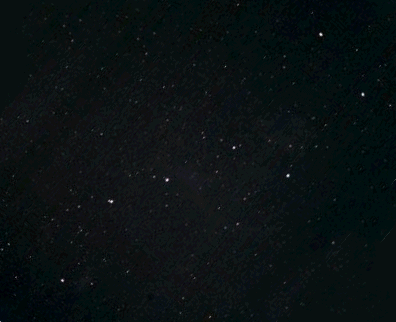
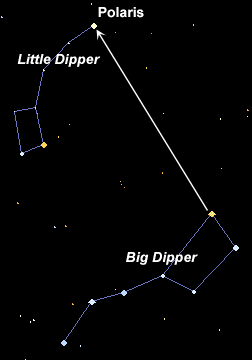 First find the 'Great Bear' or 'Big Dipper' (see photo left). This should be easy enough even in the rather light-polluted sky's of UK ..
First find the 'Great Bear' or 'Big Dipper' (see photo left). This should be easy enough even in the rather light-polluted sky's of UK ..
Now follow the 2 stars at the end of the 'bucket' (see photo right) to find the pole star (Polaris) at the end of the 'little dipper' arm.
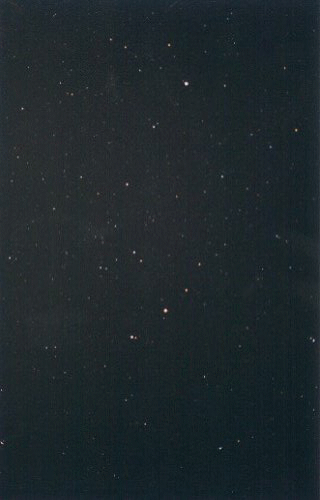
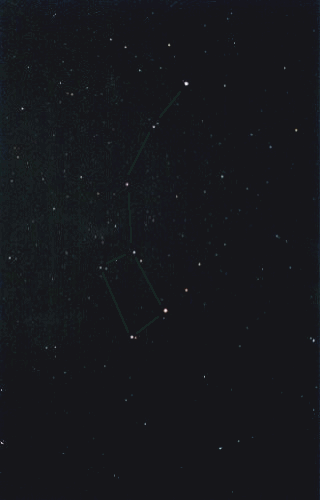 Most likely the Little Dipper will look a bit like the image on the left, however with a bit of practice you should have little trouble locating Polaris.
Most likely the Little Dipper will look a bit like the image on the left, however with a bit of practice you should have little trouble locating Polaris.
It's the bright start at the end of the little dipper 'arm'.
In fact, it's usually easier to use Polaris to find the 'little dipper', rather than the other way around :-)
The second image (right) has been enhanced a bit and the 'little dipper' drawn in.
How do I improve on basic Polaris alignment ?
To improve tracking accuracy you need to move from aligning with Polaris to aligning with the true North Celestial Pole (NCP).
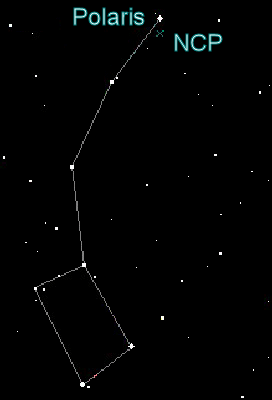 Polaris is about 3/4 degree (45 mins = 2700 seconds) off NCP, shown 'X' in the images.
Polaris is about 3/4 degree (45 mins = 2700 seconds) off NCP, shown 'X' in the images.
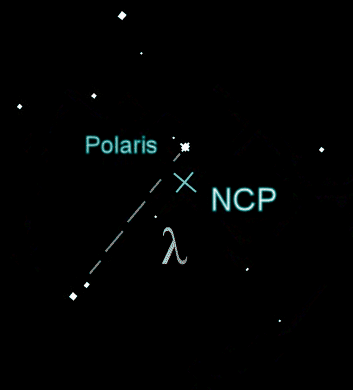
To find NCP, first track your eye 'back' down the 'little dipper arm'.
About half way toward the 'next star' making up the arm, you will find a dim star 'just off the arm' - this is Lambda Ursa Minor.
It is quite dim (+6.4 magnitude) and lies about a degree 'down the arm' (or 'up the arm', in the reversed view of a typical finder scope :- ) ) from Polaris.
The midpoint of a line drawn between Polaris and Lambda is only 20 arc minutes from the NCP. See in more detail right.
Step sideways for about 1/4 of the distance between them (in the direction of the concave side of the Little Dipper 'arm'). This will put you 'spot on' to NCP.
As long as you have cross-hairs on your finder, you should be able to get it centred within 10 arc minutes of the NCP (plus the error in the alignment of the finder with respect to the hinge).
NB. Of course you need to be able to see Lambda in the first place. In clear sky it is a naked-eye object, so you should have no trouble with the typical 8 x 30mm finder-scope.
What's the 'drift alignment' method ? (and how is it used to 'fine tune' a basic Polaris alignment)
Basically, the idea is to mount a small telescope (or camera with decent power zoom-lens) on the movable arm, center on 'any'** star and 'start up the drive'. Assuming the Drive is perfect, then, if the BarnDoor is aligned correctly, whatever stars you can see through the finder scope will "stand still" !
However if the stars 'drift' in position, then either your Polar Alignment is not 'spot on' - or your drive is not perfect. In UK, most of the 'up & down' (North / South) drift is due to Polar Alignment error (and thus most 'side to side' drift (East / West) is drive error).
** whilst 'any' star could be chosen, plainly the further away from NCP the better. This is because the further from Polaris the chosen star, the 'faster' it will move and thus the faster you will detect any 'drift' (see 'star trailing' images - the 'fastest' stars (longest trails) will be near the horizon to the South)
So all you need to do is just keep adjusting the alignment until (all) the stars stop drifting "up or down" . Of course you have to detect any drift by eye - so you may need to use something that is rather more powerful than the original 'spotter scope' (and a 'cross-hair' or 'target' graticle) eye-piece).
TIP If your Hinge 'spotter' scope has exchangeable (or zoom) eyepiece (and can be 'swung around' on its mounting), then, after a first quick check on NCP alignment (with a low mag eyepiece), the Hinge spotter scope can be put to dual use (with a high mag eyepiece).
Of more concern is that any errors in Drive speed will cause the stars to drift East/West - and there is no way to 'align out' such errors. I thus spent a lot of time perfecting the Drive system (see later).
NB. plainly it's impossible to look through the spotter 'scope at the same time as watching the clock to keep your manual wheel movement 'spot on'. Whilst 'counting' clock 'ticks' can work, drift alignment is really only usable with a camera 'live view' (or after fitting a drive motor)
How do I set up in practice ?
Start by aiming the BarnDoor (hinge) as close as possible toward the North (a compass helps, although if you have a 'SatNav' that will operate from internal batteries, you can do even better :-) ).
Next, level the base using the spirit level = every time you move the BarnDoor you will have to re-level the base, especially if the ground is not flat. If at all possible, position the Barn Door on a garden table and level the whole table.
If you now look along the edge of Hinge (visually or at low mag.) and you should see Polaris. If you have a finder scope, just turn the unit a tiny bit further to get as close as possible to NCP.
If the latitude angle is slightly incorrect, you may have to adjust the '3rd leg' of the base levelling set, thus 'tipping up' (or 'tipping down') the entire unit
Point your camera at a bright star near the south horizon and select 'live view' mode (if you don't have 'live view', set the camera to take multiple shots at a few seconds interval and enable the view screen display).
Now "engage the drive" i.e. start turning the drive nut wheel in time with the clock second hand. Hopefully the star you selected will be totally stationary in the camera view screen (if it's moving away quickly away, you are rotating the wheel nut in the wrong direction :-) )
The further the star is away from 'North' the faster it will drift (if the alignment is off), hence the choice of a target star 'near the horizon'.
At this stage I discovered how difficult it is to 'fractionally rotate' a heavy wooden unit sitting on an un-even surface balanced on 3 screw legs without upsetting the 'level' :-)
It I ever build another one, I will build a separate base and fit the BarnDoor movable arms as a 'unit' to this with a single pivot bolt. Having first (compass) North aligned and levelled the base, the top part of the BarnDoor unit can then be slightly rotated (to align with NCP) without having to move the Base :-)That concludes NCP alignment - click Next>> (on left) for the motor drive ...